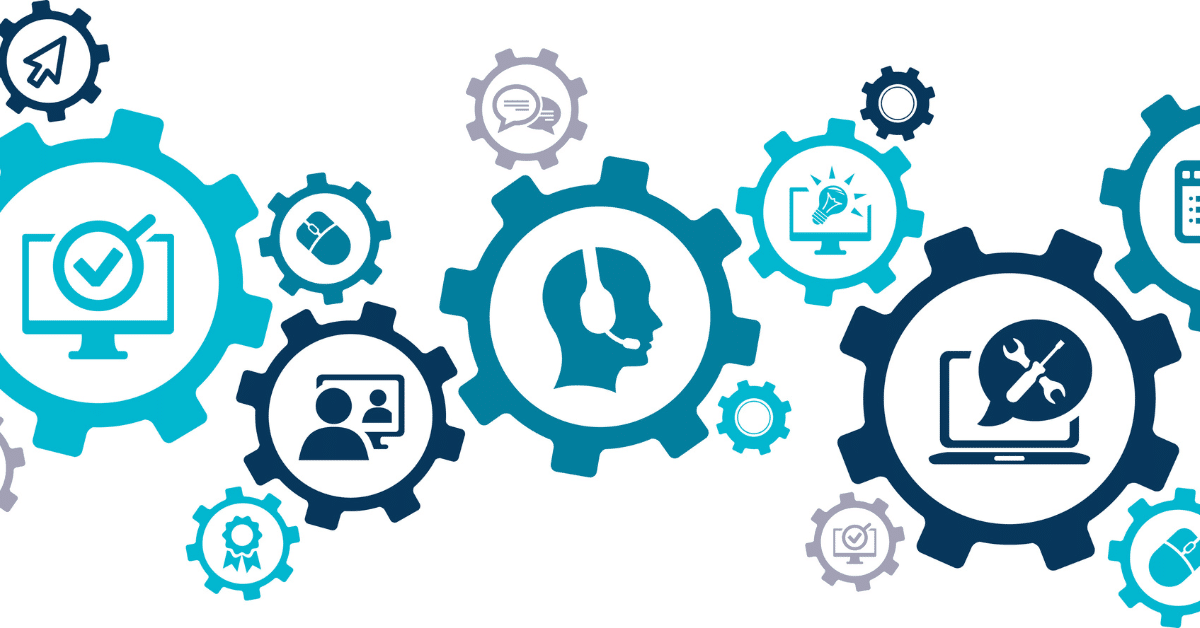Managed services can be an excellent solution for small organizations that don’t have in-house IT expertise. Unfortunately, the term “Managed IT Services” is vague, and IT professionals use it in different ways – which often leads to some confusion about what these services should encompass. So, we’ve broken down the basic types of managed IT services for small businesses that are the most important.
Table of Contents
What are Managed IT Services for Small Businesses?
Managed IT services are IT functions that businesses outsource. They contract with vendors called managed IT services providers (or MSPs) to oversee and proactively manage some or all IT requirements. This gives small businesses access to broader IT expertise and management skills than they could otherwise afford. Generally, this support is provided on an annual or monthly subscription basis.
As we mentioned in the first of this two-part managed IT services post, more than half of SMBs use a managed IT services provider. Another third of SMBs are considering it, according to a 2019 CompTIA survey report.
The 11 types of managed services for small businesses below cover two general categories:
Reactive (or “break-fix”):
The vendor responds when you have a service issue. Example: tech support, both remote and on-site.
Proactive:
You and the vendor work together to plan and maintain your IT resources, including:
- Taking precautions that minimize your risks of downtime
- Poor performance (like slow-running PCs)
- Cybercrime
Some managed IT service providers focus on large corporations that outsource specific chunks of their IT operations. However, this article focuses on small business IT services that we’ve seen work best over the 24+ years we’ve been working with them.
These are the crucial managed IT services small businesses needs to grow faster, run more efficiently, and become more secure.
What Managed IT Services Should Include
1. Strategic Planning
Your managed IT services provider should help you create an overall tech strategy that will determine how to use each of the IT services in this article. Your IT strategic plan is your blueprint. It shows how your business operates and how IT enables (and improves) those operations.
- What Strategic IT Planning Should Include
1. Regular meetings to discuss how IT can boost your company’s growth and efficiency.
Invite your IT provider to occasional board meetings and/or your annual strategic planning and budgeting sessions.
2. Documentation of your IT strategic plan and budget.
Review the results at least annually and adjust as necessary.
- How Strategic IT Planning Can Help Your Small Business
Think of strategic planning as the opposite of merely waiting for IT emergencies to strike and then responding. (Often with a monster-sized, non-budgeted capital expense.)
A good strategic plan helps you minimize emergencies. It will, at the same time, help you improve your overall operations.
Example:
It can prevent unseen productivity killers – like slow-running machines and outdated software.
2. Documenting Your System
This is typically a detailed schematic of your network systems and devices. The level of detail can vary. However, it should show how data flows through your IT infrastructure. It should comprehensively illustrate the relationship between its devices, connections, software and storage methods.
- What Documenting Your System Should Include
1. Up-front, thorough IT documentation.
An up-front thorough IT documentation of your company’s existing systems, licensing, and technology vendor information.
2. IT network diagram.
An IT network diagram to help IT vendors navigate future repairs/additions/upgrades quickly.
- How System Documentation Can Help
People who perform tasks on your IT network need an accurate “map” to work from. When that information is missing or outdated it can cause serious mishaps and delays.
Example
People who need to troubleshoot/fix an urgent problem, do an installation, run an upgrade, etc.
3. Network/Server Monitoring
IT network managers use tools that monitor a network’s general health. The tools can warn of components that have failed. Or, more importantly, tools that may need intervention, so they won’t fail.
These tools can detect certain signs of cyber attacks and other anomalies.
- What Network/Server Monitoring Should Include
1. Qualified staff on call to respond to network alerts 24/7.
Staff should be able to assess and respond to alerts generated by network monitoring tools when issues arise with your:
- Servers
- Workstations
- Cloud services
- All connected devices
- How Monitoring Can Help
The faster a qualified IT person is alerted to a potential problem; the less downtime and other mayhem is likely to occur.
Research by the consulting firm IDC showed that 80% of small businesses have suffered IT-related downtime. This operational disruption cost them between $82,200 to $256,000 for a single event.
4. Cybersecurity
In a 2019 survey of IT professionals who provide cybersecurity services for SMBs, said the top cybersecurity attacks their clients had experienced were phishing (84%), malware (84%) and ransomware (63%). These threats are still very relevant to SMBs today.

The goal of a cybersecurity program can’t be to prevent all these and other cyber attacks. That’s simply not possible for companies of any size.
The goal is to take strong, reasonable precautions to make your company a more difficult target than criminals are willing to take on. Managed IT services for small businesses is easiest way to do this.
- What Cybersecurity Services Should Include
1. Training.
Training is perhaps the most important cybersecurity protection. This is because many cyberattacks involve phishing or other tactics that rely on your employees’ ignorance. It should include new-employee training and regular updates.
2. Firewall installation, updates, and monitoring.
3. Anti-spam and antivirus protection.
Testing and maintaining your current tools. If necessary, suggesting tools that are better suited to your specific business operation.
4. Encryption for your PCs, laptops, mobile devices, and email.
5. Installation of security patches and software updates promptly.
6. Documented policies and procedures.
This way employees know how to prevent cyber losses. These should be in compliance with any applicable industry regulations. Policies and procedures should be reviewed/updated regularly.
7. Password management.
Password management (via a tool such as LastPass) so your employees have a convenient method of generating safe passwords. Alleviating the use of repeated passwords across multiple third-party sites.
8. Data backup and recovery plans.
This is a key part of cybersecurity. But backups are also important for other reasons. So, I’ve spelled this out more completely in #7 below.
9. Dark Web monitoring.
This can show you whether your employees’ user IDs, passwords, and other data are for sale on the Dark Web. This can help you track down cybersecurity lapses and guide your employee training.
- How Cybersecurity Can Help Your Small Business
Cybersecurity protects your bottom line and your reputation. According to a Nationwide Insurance survey of SMB owners, more than 20% of cyber attack victims spent at least $50,000 and took longer than six months to recover. But 7% spent more than $100,000, and 5% took a year or longer to rebuild their reputation and customer trust.
- How an MSP Can Help with Cybersecurity
Here are a couple of specific situations in which it’s important to work with a managed IT services provider that provides sophisticated cybersecurity and is highly qualified.
(Such as CompTIA Security Trustmark+, ISO 27001 certification, and SecurityScorecard).
1. Industry compliance.
If you must comply with federal and/or state cybersecurity regulations, your outsourced IT provider can help you implement and document a compliant cybersecurity program.
Example
Financial firms that face examinations by the SEC and/or FINRA or government contractors who fall under CMMC.
2. Legal liability protection.
If your company is sued over a data breach, having a professionally administered and documented cybersecurity program in place can help you. It demonstrates in court that you’ve taken reasonable measures to protect clients’ data.
5. Tech Support
Small business IT support is the process of troubleshooting IT issues to determine whether they’re mechanical breakdowns, software glitches, user errors, etc., and either correcting the situation or calling in the appropriate specialists to do so.
- What Tech Support Should Include
1. Remote support via phone or online.
2. On-site support.
On-site support for hardware problems. Also, you may want a support specialist to visit your office to train employees. Or you may want to speak with them to look for opportunities to improve operations or service.
3. Real-time online status.
Access to real-time online status of any ongoing service requests. Some issues can’t be resolved in minutes or hours. If you have an outstanding issue, you should be able to check on where that project is and what’s supposed to happen next.
- How Tech Support Can Help Your Business
The median annual salary for an IT support tech is more than $46,000 (the upper range is closer to $65,000). The benefits for about three quarters of those positions include health insurance, according to PayScale. That’s just too big of an expense for many SMBs.

We work with some firms that are big enough to have an IT person on staff, but they outsource their tech support anyway because their staffer is too busy to respond quickly to every urgent request. These companies also tend to need 24/7 coverage – and a wider range of IT experience – than one IT employee can provide.
6. Software Training and Support
In addition to answering daily software questions via help desk support (see above), some small business it services providers include software training via web-based courses or on-site training.
A managed IT services provider can administer a training program that tracks which employees need which training, and when. The provider can also monitor software updates that should prompt additional training.
- What Software Training and Support Should Include
1. Knowledge of your software.
The support staff should be proficient with the key software your employees use every day. Including industry-specific software, if possible.
2. New-employee training.
3. Refresher training.
To help employees use more of your software’s capabilities, or to help employees through software upgrades.
4. Targeted training.
For a specific function that your employees need help with.
- How Software Training and Support Can Help Your Business
Trainers who know your company well, and know how you specifically use your software, can deliver tailored curriculum. They can also answer day-to-day questions quickly and accurately.
Ultimately, managed IT services for small businesses helps you get the most productivity from your software investment through software training.
7. Data Backup and Disaster Recovery
Simply having a working data backup device does NOT give you the ability to get your operation running again quickly after a data breach, natural disaster, etc. You also need:
- Effective pre-planning
- A combination of on-site and cloud backup solutions in place
- A post-event response plan your employees know how to follow
- What Backup and Disaster Recovery Should Include
1. Assessment.
An initial assessment and test of your current backup system.
2. Configure your IT infrastructure.
Configure your IT infrastructure with redundant internet and backup services, and cloud recovery options for your servers.
3. Backup testing and monitoring.
4. Disaster recovery plan.
A detailed disaster recovery plan that’s documented and tested.
5. Backup hardware.
Options for providing backup hardware and emergency power sources.
- How Backup and Disaster Recovery Can Help Your Business
Being prepared for data loss and/or a significant business interruption can be a competitive advantage.
Sixty-eight percent of small business owners don’t have a written disaster recovery plan, according to a Nationwide Insurance survey. We bet even the 32% who do have a plan haven’t regularly tested it to make sure it will work.
In addition to avoiding major monetary losses mentioned above for business interruption and cyber-attack recovery, you’re setting yourself apart from your competitors.

8. IT Asset Management
Asset management is a system of managing your company’s hardware and software updates. It helps you have more productive staff and a more predictable budget.
The goal isn’t to always have new stuff. It’s to have equipment that effectively runs the software you need, and to avoid unplanned major capital expenditures.
- What Backup and Disaster Recovery Should Include
1. Inventory.
An inventory of your existing hardware and software. Including the age of PCs and other key hardware, and the warranty information from each manufacturer.
2. A schedule for IT equipment replacements.
This way you’re not waiting until your computers and other equipment are running slowly and breaking down before they’re upgraded.
3. Preparation of some replace computers.
To use as backups, so employees can stay productive while new equipment is purchased and set up.
- How Asset Management Can Help Your Business
A survey conducted by ZenBusiness, a startup support company, revealed that:
- Two-thirds of the workers who participated in the survey reported that outdated technology has a moderate (50.2%) to major (16.2%) impact on their productivity.
- Additionally, more than 4 out of 10 workers stated that outdated technology has a moderate (28.2%) to major (12.2%) effect on their job satisfaction.
- The most cited outdated technologies by the respondents were computers (83.1%) and software (70.5%).
Asset management helps you keep your technology up to date which allows you to manage your IT capital expenses.
Managed IT services for small businesses does a great job of improving productivity and job satisfaction. Asset management is just one example.
9. Mobile Device Management and Support
In IT industry jargon, mobile device management (MDM) tools help companies deploy, track, and protect mobile devices. (That includes devices like smartphones, tablet computers, and laptops.)
Your small business IT service provider should be familiar enough with your devices and data plan providers to answer employee questions. Which, incidentally, often come from people who are on the road and need help right away.
- What Backup and Disaster Recovery Should Include
1. Security protection and encryption.
On all mobile devices. Including the ability to wipe proprietary data from a device remotely in case it is lost or stolen.
2. Device setup and configuration.
For email accounts, calendars, industry-specific apps, etc.
3. Data backup and recovery.
- How Mobile Device Management Can Help Your Business
In its forecast of five cybersecurity trends for 2020, the cybersecurity firm, Digital Shadows includes: “Mobile devices will increasingly be targeted as more business processes and payment options migrate to mobile.”
Many such lists include similar warnings about mobile devices.
Give your company the productivity advantages of mobile devices. While your managed IT services provider addresses the additional cybersecurity risks that mobile devices create.
10. Technology Vendor Management
Small business IT service providers help their clients choose from myriad subcontractors to find the right mix and stay within the client’s budget.
Example:
You may be able to improve operations and save money by using one or more cloud-based services. Your provider can help you sift through cloud options. Then, monitor and manage these services for you.
- What Vendor Management Should Include
1. Resolution of service issues.
Including contacting any necessary providers (software vendors, internet, phone, firewall, etc.) on your behalf.
2. Management of disputes between vendors.
Sometimes tech providers will point fingers at one another over the source of a service issue. Let your IT partner sort it out.
3. Regular cost assessment.
To look for better values.
- How Vendor Management Can Help Your Business
Your time and energy are best spent on growing your business. Not comparing cloud backup service packages, or sitting on hold with Microsoft over an Office 365 issue, etc. Delegate that stuff to an IT partner who does these things every day.
11. IT Project Management
This service is a blend of many of the other 10 services shown above. They’re based on whichever solutions are necessary to organize and execute a major project that involves IT.
Typical projects include:
- Upgrading to a new operating system (like Windows 7 to Windows 10)
- Major hardware installations
- Equipping a new conference room with A/V and teleconferencing gear
- Migrating backup data onto a new on-premises or virtual server
- What IT Project Management Should Include
1. Project logistics.
Creating a timetable of events that you can use to communicate with your employees. That way they understand what they will need to do and when.
2. Support for larger projects that include an IT component.
Such as opening or moving a branch office or hiring a batch of new employees. Or contractors that require access to your network.
- How IT Project Management Can Help Your Business
Experienced IT project managers know how to minimize business interruption and general confusion among your employees and clients. This takes the major oversight duties off your plate. And results in fewer unpleasant surprises.
Two Key Billing Considerations for IT Managed Services
Reactive providers sell their services as separate, hourly occurrences or as subscriptions. Proactive providers often sell their services through a yearly contract or monthly subscription.
We provide our proactive services to clients on a contractual basis. We recommend this approach to ensure that your technology is strategically aligned with your business goals. Make sure you hire the right support for your small business.
The checklist below was designed to help guide you through the evaluation process of multiple MSPs – ensuring you get the IT expertise your business needs.

Use this checklist to make choosing the right managed service provider for your organization easy and stress-free.
Forget an Overhaul, Create an “IT Blueprint”
Because every organization is unique, your company may need services not listed above. But whichever mix you choose to use, be careful about implementing too much, too quickly.
Complete IT overhauls can be too difficult for your employees or clients to deal with. Create an “IT blueprint” with your provider. Then, work toward it gradually. Make sure each change is working as it should and adjust the blueprint as necessary.
Continue that process until your IT operations match the blueprint.
Remember, different providers have different terminology for all the managed IT services we listed. So be sure to ask a lot of questions.
The provider’s ability to answer your questions in plain English is an excellent gauge of how good that provider’s service will be.
Get the IT Solutions You Deserve Today
Teal offers responsive and secure managed IT services to SMBs nationally, with local IT services provided in:
Established in 2000, we enrich lives by delivering ultra-responsive services, prioritizing integrated cybersecurity, and investing in our staff.
If you still have questions about managed IT services for small businesses, feel free to contact us today. We’d be happy to answer them or point you in the right direction.










